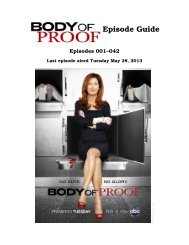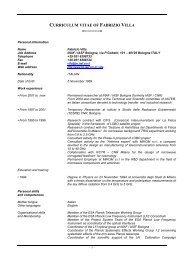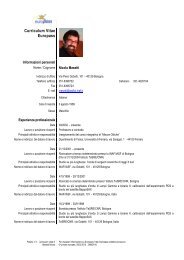Agatha Christie's Poirot Episode Guide - inaf iasf bologna
Agatha Christie's Poirot Episode Guide - inaf iasf bologna
Agatha Christie's Poirot Episode Guide - inaf iasf bologna
Create successful ePaper yourself
Turn your PDF publications into a flip-book with our unique Google optimized e-Paper software.
<strong>Agatha</strong> Christie’s <strong>Poirot</strong> <strong>Episode</strong> <strong>Guide</strong><br />
Death in the Clouds (1)<br />
Season 4<br />
<strong>Episode</strong> Number: 35<br />
Season <strong>Episode</strong>: 3<br />
Originally aired: Sunday January 12, 1992<br />
Writer:<br />
<strong>Agatha</strong> Christie, William Humble<br />
Director: Stephen Whittaker (II)<br />
Show Stars: Philip Jackson (Chief Inspector James Japp), David Suchet (Hercule<br />
<strong>Poirot</strong>)<br />
Guest Stars: Harry Audley (Barraclough), John Bleasdale (Mitchell), Jenny Downham<br />
(Anne Giselle), David Firth (Lord Horbury), Cathryn Harrison<br />
(Lady Horbury), Roger Heathcott (Daniel Clancy), Richard Ireson (Inspector<br />
Fournier), Gabrielle Lloyd (Elise), Guy Manning (Jean Dupont),<br />
Eve Pearce (Madame Giselle), Amanda Royle (Venetia Kerr), Shaun<br />
Scott (Norman Gale), Sarah Woodward (Jane Grey)<br />
Summary: <strong>Poirot</strong> falls asleep on a short aeroplane flight from Paris to London,<br />
and one of the other passengers, Madame Giselle, is killed by a poison<br />
dart while he sleeps. <strong>Poirot</strong> finds out that she was a money-lender,<br />
which may provide a motive for the killing.<br />
Frustrated with the evident artificiality of the blowpipe,<br />
an item that could hardly have been used without<br />
being seen by another passenger, <strong>Poirot</strong> suggests that<br />
the means of delivering the dart may have been something<br />
else. Is it the flute of one passenger, or perhaps<br />
one of the ancient tubes carried by one of the two French<br />
archaeologists on board? Or maybe Lady Horbury’s long<br />
cigarette holder?<br />
<strong>Poirot</strong>’s focus is upon a wasp that has been seen in<br />
the compartment and which provided evidence for the<br />
original theory of the cause of death. Without explaining<br />
himself, he asks for a detailed list of the items in<br />
the possession of the passengers, and finds an incriminating<br />
clue: Norman Gale, a dentist who has seemingly<br />
never been in the area of the plane where the victim<br />
was killed, and has no apparent motive for committing<br />
the murder, had an empty matchbox and a lighter. He<br />
appears to be the killer, but how can he have committed<br />
the murder, when he was apparently in conversation<br />
with Jane Grey (the novel’s effective heroine) throughout<br />
the flight? And why would he have committed the<br />
crime? And why were there two coffee spoons in the victim’s<br />
saucer?<br />
Madame Giselle is suspected of using blackmail to ensure that her clients pay up, so any<br />
one of the passengers could either have owed her money or feared exposure. Equally, Madame<br />
Giselle had an estranged daughter who inherits her considerable estate: could one of the female<br />
passengers be this heiress? Much of the novel focuses on the pursuit of this line of enquiry,<br />
with the passengers coming under suspicion in turn. Special attention is given to Mr. Clancy, a<br />
detective novelist who enables Christie to include the same sort of parodies of her craft achieved<br />
in other novels through the character of Ariadne Oliver.<br />
The only other suspect who proves of material significance is, however, the Countess of Horbury,<br />
whose maid has been called into the compartment during the flight where she would have<br />
77

















